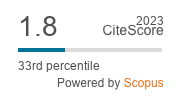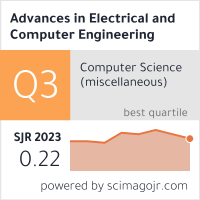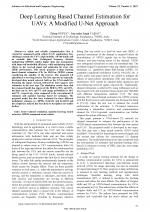| 1/2025 - 7 |
Deep Learning Based Channel Estimation for UAVs: A Modified U-Net ApproachGUPTA, C. |
| Extra paper information in |
| Click to see author's profile in |
| Download PDF |
Author keywords
channel estimation, machine learning, neural networks, OFDM, unmanned aerial vehicle
References keywords
communications(16), channel(12), ofdm(10), estimation(10), deep(10), communication(10), systems(9), learning(7), networks(6), letters(6)
Blue keywords are present in both the references section and the paper title.
About this article
Date of Publication: 2025-02-28
Volume 25, Issue 1, Year 2025, On page(s): 61 - 70
ISSN: 1582-7445, e-ISSN: 1844-7600
Digital Object Identifier: 10.4316/AECE.2025.01007
SCOPUS ID: 86000354176
Abstract
A stable and reliable communication link is crucial for unmanned aerial vehicle (UAV) applications. Key challenges include the UAV's high mobility (10-100 km/h) and an unstable data link. Orthogonal frequency division multiplexing (OFDM) enables higher data rate transmission with improved bandwidth efficiency, while minimizing channel effects on the received signal and enhancing bit error rate (BER) performance. This article proposes a deep learning based channel estimation (CE) for 802.11ac OFDM systems considering the mobility of the receiver. The proposed CE algorithm is a two-step process. The first step uses an especially developed deep neural network built on the U-Net model for denoising the signal received, followed by least squares (LS) estimation in the next step. The simulation results show that the proposed model has improved the BER by 50% and 40%, the data rate by 10% and 7% and outage probability by 10% and 7%, respectively, when compared to the conventional LS estimator and machine learning based LS estimator. The proposed model has also been evaluated for three different modulation schemes, i.e., QPSK, 16-QAM, and 64-QAM and the complexity analysis has been done to strengthen our studies further. |
| References | | | Cited By |
Web of Science® Times Cited: 0
View record in Web of Science® [View]
View Related Records® [View]
Updated 4 days, 9 hours ago
SCOPUS® Times Cited: 0
View record in SCOPUS® [Free preview]
There are no citing papers in the CrossRef Cited-by Linking system.
Disclaimer: All information displayed above was retrieved by using remote connections to respective databases. For the best user experience, we update all data by using background processes, and use caches in order to reduce the load on the servers we retrieve the information from. As we have no control on the availability of the database servers and sometimes the Internet connectivity may be affected, we do not guarantee the information is correct or complete. For the most accurate data, please always consult the database sites directly. Some external links require authentication or an institutional subscription.
Web of Science® is a registered trademark of Clarivate Analytics, Scopus® is a registered trademark of Elsevier B.V., other product names, company names, brand names, trademarks and logos are the property of their respective owners.
Faculty of Electrical Engineering and Computer Science
Stefan cel Mare University of Suceava, Romania
All rights reserved: Advances in Electrical and Computer Engineering is a registered trademark of the Stefan cel Mare University of Suceava. No part of this publication may be reproduced, stored in a retrieval system, photocopied, recorded or archived, without the written permission from the Editor. When authors submit their papers for publication, they agree that the copyright for their article be transferred to the Faculty of Electrical Engineering and Computer Science, Stefan cel Mare University of Suceava, Romania, if and only if the articles are accepted for publication. The copyright covers the exclusive rights to reproduce and distribute the article, including reprints and translations.
Permission for other use: The copyright owner's consent does not extend to copying for general distribution, for promotion, for creating new works, or for resale. Specific written permission must be obtained from the Editor for such copying. Direct linking to files hosted on this website is strictly prohibited.
Disclaimer: Whilst every effort is made by the publishers and editorial board to see that no inaccurate or misleading data, opinions or statements appear in this journal, they wish to make it clear that all information and opinions formulated in the articles, as well as linguistic accuracy, are the sole responsibility of the author.



